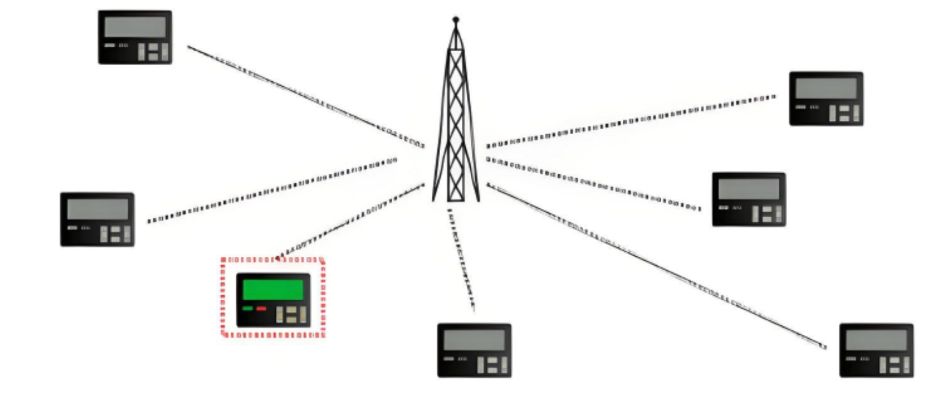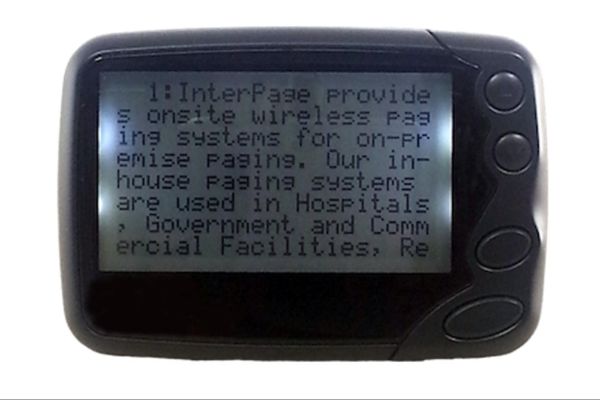

Updated · Feb 11, 2024
Updated · Jul 31, 2023
Aditya is an Azure DevOps and Infrastructure Virtualization Architect with experience in automation,... | See full bio
April is a proficient content writer with a knack for research and communication. With a keen eye fo... | See full bio
|
Definition A pager or a beeper is a wireless telecommunication device that receives and shows alphanumeric texts or voice messages. It beeps when it receives a signal, and depending on the pager device, you can send back a signal. Even though pagers are no longer famous today, it is still relevant to specific industries like public safety and healthcare.
|
Continue reading this article to learn more about what a pager is in this article, along with the following:
Let’s get started.
In the late 20th century, pagers revolutionized personal and professional communication. It enabled people to send and receive messages while on the move without the need for landlines. However, with more advanced communication tools, pagers became less popular, and their use declined.
Here is a timeline that explores the rise and fall of pagers:
Having learned about the history of pagers, let's now shift our focus to their functionality. Continue reading to learn how pagers work, providing valuable insights into their continued relevance and usage in specific situations.
All pagers work the same way — by receiving radio signals. You must have a personal code number (similar to a phone number) to get messages. The person who wants to contact you must input this number with their message.

The paging network's transmitters broadcast the signals over a particular frequency. Pagers within the range listen to the signal.
Each pager device has its Channel Access Protocol (CAP) code, a unique identification address. When the pager hears its CAP code, it receives the message.
Depending on the pager type, the pager notifies you with a beeping sound or vibration.
|
|
There are five different types of pagers. Some pager types only show numbers, while others display numbers and letters. There are pagers for which you can’t send back a signal, while others allow you to send one back. Discover more such differences between different types of pagers.
Alert-only pagers are the simplest form of paging. The old version of this type of pager alerts the user that it received a message by giving a beeping sound. The versions after that notify by a blinking light or vibration. Some versions of this type have a combination of alerts.

This type of pager is commonly used in restaurants and nursing homes. Users have control over the information that they receive. They can easily see or monitor without other distractions.
For instance, the loved ones of the elderly can receive a notification from the nursing home about any improvements or urgency.
This type of pager can send a message with numbers like a phone number. Like alert-only pagers, it notifies the user of a sound, light, or vibration. Numeric pagers are usually used in the healthcare industry to find files and monitor patients.

Alphanumeric pagers can send a message with numbers and words. This pager also alerts its user when it receives a light, vibration, or sound alert message. Like the alert-only and numeric pagers, alphanumeric pagers can only receive a message.

As its name suggests, this pager can send and receive messages with numbers and words. Unlike the first three types, this pager can "reply" to the message. This device has a built-in tiny keypad (QWERTY keyboard) where the users can type their messages.

Two-way alphanumeric pagers are standard in the healthcare industry but have also become popular for personal messaging. Users can connect this pager to a computer when downloading long text messages.
Voice beepers can play a recorded audio message after notifying their users of the message. This type of pager is vital in businesses for customer service and in hospitals for emergencies. Users can immediately know what the message is about by playing the audio.

Pagers have two main systems where these pager types are applicable. First is the on-site paging systems for restaurants or hospitals with smaller desktop transmitters. Second is the national paging networks which have set up towers.
|
⌛ In a Nutshell: Pagers come in five types: alert-only pagers, numeric pagers, alphanumeric pagers, two-way alphanumeric pagers, and voice beepers. Each type has specific use cases in industries like healthcare and customer service. |
After learning the different types of pagers, we’ll take a closer look at the pros and cons of pagers in the next section.
Pagers have stood the test of time as a reliable communication tool in an ever-evolving technological landscape. However, like any technology, pagers have their strengths and limitations.
Whether you are a nostalgic advocate or a skeptic seeking modern alternatives, continue reading to learn the pros and cons of pagers.
Pagers may seem like old technology, but they still have many advantages over modern communication methods. Here are some advantages of using pagers:
Pagers send data using Very High Frequency (VHF) radio signals (138 to 466 MHz). This range is similar to a typical FM radio program.
The signals can reach farther, suffer fewer interferences, and requires fewer transmitters. A pager’s connection is ideal for remote areas or long-distance rescues.
Paging systems for an on-site network are reliable for mass communication because it offers reliable and secure messaging. Network providers hard-wire the network to the infrastructure of the building. This advantage allows professionals to simultaneously send mass texts and connect to different building areas send.
With a pager, hospital staff don't have to call the patients out loud because pagers can give specific messages and notifications to patients. This leads to:
Pagers are simple for the elderly, children, and people with different abilities. This device is light, small, compact, and has a long-lasting battery life. The users can make quick decisions since they can immediately focus on the message.
Some businesses are considering removing pagers in their operations. Let’s see what drawbacks pagers have. Below are some of them:
If you sent a message to a pager, there is no way for you to know if the pager received it. A pager wouldn’t receive a message when it’s out of the transmitter's range or turned off.
You must send the message repeatedly until the person responds. This issue is why some people inform their colleagues to keep paging them until they respond.
Due to their limited display capabilities, pagers can only receive and display messages with 160 characters. If you need to see a long text, you will need assistance from a computer.
Pagers can only connect to one network. This limitation can cause workflow gaps and the businesses to spend more.
In a study of Healthcare Information and Management Systems Society Analytics (HIMSS), some hospitals consider integrating mobile devices to address this issue.
Given the advantages and disadvantages of pagers, let’s find out who uses them today.
Many consumers still find pagers helpful today despite the rise of new technology. Find out who still uses pagers in this section:
One-way and two-way pagers give immediate situational awareness in public safety operations. According to the National Council of Statewide Interoperability Coordinators (NSWIC), pagers are a vital link for public safety.
Pagers facilitate simultaneous alerts to situations that require an appropriate response. This device also supports personnel safety and incident management.
Businesses, and the government still spend money on communication using pagers. The messaging that happens using pagers is direct to the point and doesn't drain the batteries quickly. Pagers help EMTs and firefighters to respond and decide fast during emergencies.
Many physicians and surgeons still use pagers to connect and communicate at work. Pagers' simplicity and low-tech feature makes transmitting patients' sensitive data more confidential. Doctors see pagers as a reliable way to relay brief data.

Pagers are still critical for birdwatching enthusiasts and competitors. Some of the birdwatchers subscribe to alerts on a bird sighting nearby. Using pagers for birdwatching is more popular in competitive leagues in bird-watching.
Communication is essential in our interconnected world, and the debate between pagers and smartphones has been ongoing. Both devices have influenced how we stay connected, but they have different features, applications, and areas of use.
Here is a comparison between pagers and smartphones.
|
Pagers |
Smartphones |
|
|
Features |
Pagers don’t have additional features. |
Cellphones have cameras, games, GPS, applications, and more. It also has built-in software to receive and make calls. |
|
Battery Life |
Rechargeable and replaceable AA batteries lasting 1 to 4 months. |
Rechargeable lithium-ion battery that could last 1 to 4 days. |
|
Privacy |
Most pagers are untraceable. |
A smartphone and its locations can be traced through phone numbers, GPS,and IP address. |
|
Area of Use |
Fire stations, hospitals, restaurants, and other healthcare and hospitality fields |
Anywhere except where smartphones are not allowed, like airplanes and gas stations. |
|
Messaging |
You can send texts, audio, and numbers. The message is direct and brief, which can lack context. |
You can send videos, images, texts, numbers, files, and many other forms of content. You can pack all the details needed before sending. |
|
Connection |
Pagers have a strong signal network. This is why some users in rural areas prefer using pagers. |
Smartphones have a “dead zone,” which refers to areas in a building that don’t have reception. |
The table presented above provides a clear comparison between pagers and Smartphones. Pagers are particularly useful in professional environments like fire stations and hospitals where reliability, extensive battery life, and strong signal coverage are prioritized.
 |
71% of users sleep with or near their mobile phones |
On the other hand, Smartphones offer a wide range of features that enable users to share multimedia content and stay connected from almost any location.
When choosing between a pager and a cell phone, the decision should be based on the individual's communication needs and preferences.
A pager is a wireless communication device used in the healthcare, hospitality, and public safety industries. It receives CAP signals from a transmitter to receive a message. Messages can be text, number, or audio depending on the pager type.
The main page types are alert-only, numeric, alphanumeric, two-way, and voice beepers. Using pagers has pros and cons. Today, you might still need pagers in your job or business.
Motorola coined the term "pager" by combining its walkie-talkie and car radio technologies into a transistorized pager. The then new pager receives radio signals from paging networks.
The phone network or internet can fail. Pager systems have more reliable signals for communication. Pagers are ideal for security companies and emergency service providers.
There is no need for a sim card in using a pager. Instead, they use radio signals to relay messages.
The device is famously known as a pager at first. Eventually, the society called it “Beeper” or “Bleeper” because of the sound, it makes when it receives a signal.
Your email address will not be published.
Updated · Feb 11, 2024
Updated · Feb 11, 2024
Updated · Feb 08, 2024
Updated · Feb 05, 2024



